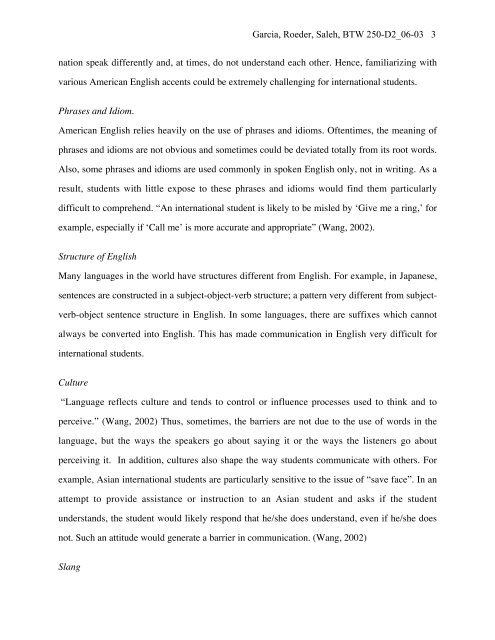Language Barriers in the University of Illinois Urbana ... - ideals
Language Barriers in the University of Illinois Urbana ... - ideals
Language Barriers in the University of Illinois Urbana ... - ideals
You also want an ePaper? Increase the reach of your titles
YUMPU automatically turns print PDFs into web optimized ePapers that Google loves.
Garcia, Roeder, Saleh, BTW 250-D2_06-03 3<br />
nation speak differently and, at times, do not understand each o<strong>the</strong>r. Hence, familiariz<strong>in</strong>g with<br />
various American English accents could be extremely challeng<strong>in</strong>g for <strong>in</strong>ternational students.<br />
Phrases and Idiom.<br />
American English relies heavily on <strong>the</strong> use <strong>of</strong> phrases and idioms. Oftentimes, <strong>the</strong> mean<strong>in</strong>g <strong>of</strong><br />
phrases and idioms are not obvious and sometimes could be deviated totally from its root words.<br />
Also, some phrases and idioms are used commonly <strong>in</strong> spoken English only, not <strong>in</strong> writ<strong>in</strong>g. As a<br />
result, students with little expose to <strong>the</strong>se phrases and idioms would f<strong>in</strong>d <strong>the</strong>m particularly<br />
difficult to comprehend. “An <strong>in</strong>ternational student is likely to be misled by ‘Give me a r<strong>in</strong>g,’ for<br />
example, especially if ‘Call me’ is more accurate and appropriate” (Wang, 2002).<br />
Structure <strong>of</strong> English<br />
Many languages <strong>in</strong> <strong>the</strong> world have structures different from English. For example, <strong>in</strong> Japanese,<br />
sentences are constructed <strong>in</strong> a subject-object-verb structure; a pattern very different from subjectverb-object<br />
sentence structure <strong>in</strong> English. In some languages, <strong>the</strong>re are suffixes which cannot<br />
always be converted <strong>in</strong>to English. This has made communication <strong>in</strong> English very difficult for<br />
<strong>in</strong>ternational students.<br />
Culture<br />
“<strong>Language</strong> reflects culture and tends to control or <strong>in</strong>fluence processes used to th<strong>in</strong>k and to<br />
perceive.” (Wang, 2002) Thus, sometimes, <strong>the</strong> barriers are not due to <strong>the</strong> use <strong>of</strong> words <strong>in</strong> <strong>the</strong><br />
language, but <strong>the</strong> ways <strong>the</strong> speakers go about say<strong>in</strong>g it or <strong>the</strong> ways <strong>the</strong> listeners go about<br />
perceiv<strong>in</strong>g it. In addition, cultures also shape <strong>the</strong> way students communicate with o<strong>the</strong>rs. For<br />
example, Asian <strong>in</strong>ternational students are particularly sensitive to <strong>the</strong> issue <strong>of</strong> “save face”. In an<br />
attempt to provide assistance or <strong>in</strong>struction to an Asian student and asks if <strong>the</strong> student<br />
understands, <strong>the</strong> student would likely respond that he/she does understand, even if he/she does<br />
not. Such an attitude would generate a barrier <strong>in</strong> communication. (Wang, 2002)<br />
Slang
















